Subscribe to eyeMatters periodic news
"*" indicates required fields

Common eye conditions in kids
1. Paediatric eye injuries
Kids are at particular risk for eye injuries and trauma, especially toddlers who lack motor coordination.1 Eye injuries can include having an object caught in the eye (known as a foreign body). Other common injuries include accidentally bumping the head and face, falling over or off something, sporting injuries or being hit by a projectile toy. There is a high risk of eye damage in kids from Nerf guns and similar shooting-style products.1–3 Children are often understandably distressed if they have suffered any eye trauma. The surface of the eye (cornea) is extremely sensitive, so any eye injury can be very painful for children. Learn how the eye works.
For all children’s eye injuries, seek emergency care from an eye health professional without delay.
Chemical injuries
A chemical injury can occur with many household and garden products, which is why it is important to put these high up, out of reach from children or in a lockable cupboard. Some examples include bleaches, detergents and cleaning sprays. If your child gets a chemical splash into their eye, immediately wash the eyes under a running tap for 15–30 minutes.
For younger children who find this difficult, try splashing cups of water into their eyes. Alternatively, stand them under a warm shower and wipe their eyelids from inside to out. This helps water enter the eyes and flush the chemical out. Once the eyes are thoroughly washed out, have your child reviewed by a paediatric ophthalmologist or the closest eye emergency department as soon as possible. This is especially important if your child’s eyes continue to feel sore or are red and weepy. Numbing eye drops are used to make your child comfortable and also allow the ophthalmologist to get a good look at all the eye’s structures. In some situations, we may need to give your child eye drops to help it heal.
A prompt, thorough washout of the eyes and early review by a paediatric ophthalmologist is the key to prevent severe damage in a chemical injury.
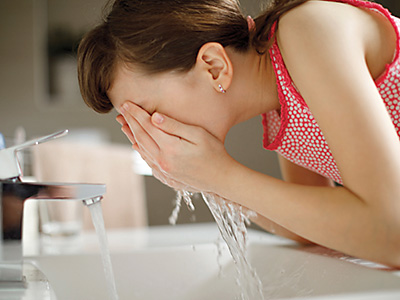
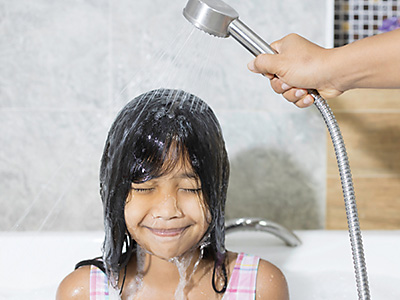
Knocks to the eye
If your child has received blunt force to the eye such as a knock, treat immediately with a cold compress to minimise any swelling. If you are using an ice pack, cover it with a tea towel, t-shirt or sock so it does not directly touch the delicate skin of the eyelids. Apply the compress for up to 10 minutes at a time, with breaks of 10 minutes in between. Seek medical attention for your child if:
- a projectile such as a Nerf bullet was involved
- there is visible damage or bleeding
- there is increasing redness or any change in vision
- they are in pain
- you are concerned.
Corneal abrasions
We commonly see corneal abrasions from fingernails, toys or a foreign body. A simple test using a fluorescein strip can confirm the presence of an abrasion. Luckily, most are mild and heal by themselves within a few days.4,5 However, your child should still be assessed medically as some abrasions require topical medication or occasionally an eye patch to promote healing.
Younger kids cannot describe their symptoms accurately, which may include important changes to their vision. It is always safest to have your child assessed promptly by a paediatric ophthalmologist, even if an injury seems mild.
Foreign bodies
Common examples of foreign bodies in a child’s eye include glitter, sand, dirt and eyelashes. If your child has something in their eye, gently hold open their eyelids (with clean hands) to have a look for the offending object. Ask your child to look up and down and sideways, as this may reveal the foreign body. You can also get them to blink several times.
This may be enough to get a small foreign body to move towards the inner corner of the eye where it can be flushed out easily with the child’s tears, sterile saline or water. If necessary, start flushing the eye out under running water. Stop every five minutes and check if the object has come out. Seek urgent medical help if it is still present after 30 minutes of flushing, they complain of a change in their vision, they are in pain, they won’t open their eye, or you are worried. Never try to remove the object with your fingers, a cotton bud, tweezers or anything else as you could cause damage.
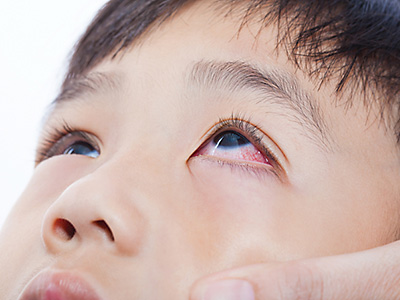
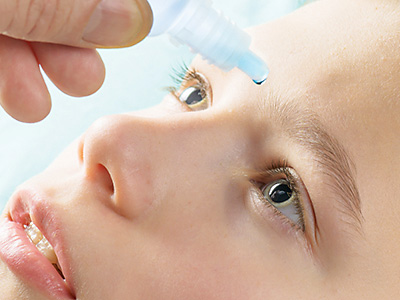
If the foreign body has penetrated into the eye, call an ambulance. Do not attempt to remove it and make sure your child does not touch the eye.
2. Paediatric conjunctivitis
Conjunctivitis is one of the most common eye conditions in kids and adults alike and can be uncomfortable and irritating to patients. Conjunctivitis is an inflammation of the conjunctiva (the transparent, blood vessel–rich layer covering the white part of the eye). The blood vessels become swollen and prominent when inflamed, causing the eye to look red or pink. This is why conjunctivitis is also called ‘pink eye’. Children develop conjunctivitis most commonly from a viral infection but also allergies and bacterial infection.6 It is hard to tell which type of conjunctivitis it is without a microscope. If there are any concerns, assessment by a paediatric ophthalmologist is recommended.
Allergic conjunctivitis
Allergic conjunctivitis commonly occurs in kids during spring but can occur at any time of the year. It can be a cause of your child’s red eye, especially if they have associated symptoms of itchiness, hay fever and asthma. It is important to have a review by a paediatric ophthalmologist if your child’s symptoms persist despite treatments over the counter, or from a GP or optometrist. This is important if the symptoms affect your child’s vision and day-to-day activities. We can treat most cases with a simple course of eye drops, usually lasting between 2 and 6 weeks. Steroid drops may be prescribed, and these are very safe to use in small doses. Some children may get severe allergic eye disease. Luckily, a range of treatment regimens is available for these patients.
Viral conjunctivitis
Children can get viral conjunctivitis throughout the year – it is extremely contagious and can be easily caught in the community. Viral conjunctivitis can be associated with other flu-like symptoms such as a cough, runny nose and sneezing. Most cases will improve on their own, but there are some things you can do to make your child more comfortable. For example, regular eyelid hygiene using a hot (not scalding) wet face cloth to gently scrub the surface of the eyelids from inside to out. This removes all the flakes and debris from the eyelashes and helps reduce mucus buildup. The heat can also reduce the inflammation to make the eyes feel more comfortable. Always ensure your hands are clean before touching your child’s face. Most cases of viral conjunctivitis can be managed by a GP or optometrist. However, if the symptoms of a red eye, watery eye and mucous persist for longer than two weeks and/or vision is affected, have your child reviewed by an ophthalmologist. In some cases, the virus can distort vision and steroid eye drops are needed.
Bacterial conjunctivitis
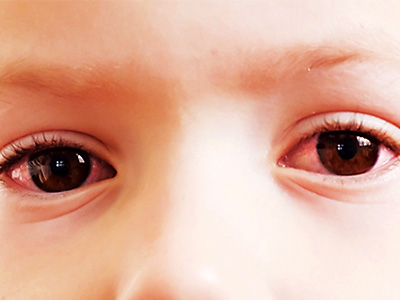
Bacterial conjunctivitis in children can occur from any bacteria that contaminate the eye. Your child may have a thicker, yellowish mucous compared to the other types of conjunctivitis, but it is often hard to tell the difference. Antibiotics drops or ointment are needed to eliminate the bacteria. As mentioned previously, regular eyelid hygiene can help make your child feel much more comfortable. In rare cases, medicated tablets are needed to treat the conjunctivitis – this depends on the severity of the condition and associated eye problems.
Most patients with conjunctivitis recover with good vision. Rarely, conjunctivitis can be so severe it leads to impaired vision. If you have any concerns about your child, consult a paediatric ophthalmologist.
Learn more about our children’s eye health service
Most commonly asked questions about children’s eye health
Cataracts in children
How to reduce the risk of your child developing myopia
References
1. American Academy of Ophthalmology. Paediatric Ophthalmology Education Center. Trauma: Introduction. USA, 2015. Available at https://www.aao.org/disease-review/introduction-to-trauma [Accessed online 15 February 2021].
2. Bizrah M, Verma S. Nerf gun eye injuries: traumatic hyphema. BMJ Case Rep 2017;2017:bcr2017220967.
3. Boret C, Brehin C, Cortey C et al. Pediatric ocular trauma: Characteristics and outcomes among a French cohort (2007-2016). Arch Pediatr 2020;27(3):128–34.
4. American Association for Paediatric Ophthalmology and Strabismus. Corneal Abrasions. USA, April 2020. Available at https://aapos.org/glossary/corneal-abrasions [Accessed online 15 February 2021].
5. Domingo E, Moshirfar M, Zabbo CP. Corneal Abrasion [Updated 2020 Jul 12]. In: StatPearls [Internet]. Treasure Island (FL): StatPearls Publishing; 2020. Available at https://www.ncbi.nlm.nih.gov/books/NBK532960/ [Accessed online 15 February 2021].
6. Azari AA, Barney NP. Conjunctivitis: A Systematic Review of Diagnosis and Treatment. JAMA 2013;310(16):1721–30.
The information on this page is general in nature. All medical and surgical procedures have potential benefits and risks. Consult your ophthalmologist for specific medical advice.
Date last reviewed: 2025-10-28 | Date for next review: 2027-10-28
